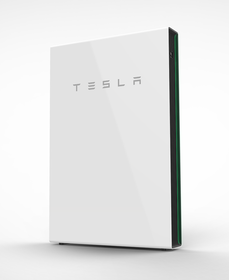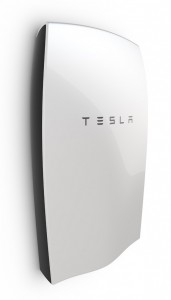

Tesla Powerwall Review & Guide
The Tesla Powerwall was by no means the first solar battery, but it did attract the most attention – and for good reason – with the Tesla Powerwall and its successor, the Tesla Powerwall 2, widely considered to be some of the go-to solar batteries on the market. But does the Tesla Powerwall actually live up to the hype? Canstar Blue reviews the full Tesla Powerwall range, looking at the specs, prices and capabilities, to see if it’s worth exploring and installing in your home.
On this page:
Advertisement
Tesla Solar Batteries
Tesla offers a number of residential solar batteries with its Powerwall range, although only the Powerwall 2 model is currently available in Australia. In this guide will look at the specs, costs and availability of each model, which you can read below.
Tesla Powerwall 2

Released in 2016, one year following the release of Tesla’s first Powerwall, the Powerwall 2 came with plenty of upgrades. In addition to a smaller, rectangular design, the Tesla Powerwall 2 has 14kWh of storage capacity – twice the size of the first model and enough to cover the majority of a household’s electricity demands. It also has a proportionately higher discharge rate, allowing it to power more appliances at any one time.
The Powerwall 2 is more durable than the original and comes with a warranty for 10 years or 37,800kWh of discharged electricity (whichever comes first). Tesla also guarantees the Powerwall 2 will still have at least 70% of its capacity left at the end of the warranty. The only discernible shortfall of the Powerwall 2 is that it’s slightly less efficient, with a round-trip efficiency of 89%, 3.5% lower than the previous version. Below are the main specs for the Tesla Powerwall 2.
| Power, Continuous & Peak | 5kW |
| Total Energy | 14kWh |
| Usable Energy | 13.5kWh |
| Round trip efficiency | 90%* |
| Depth of Discharge | 100% |
| Voltage | 230V |
| Operating temperature | -20°C – 50°C |
| Weight | 114kg |
| Dimensions | 115cm L; 75.3cm W; 14.7cm D |
| Warranty | 10 year |
* Efficiency at beginning of Powerwall life
Tesla Powerwall 2 Price
The price of the Tesla Powerwall 2 will be upwards of $15,000, with an additional $1,000-$2,000 for supporting hardware and installation, depending on your location and installer of choice.
Where can I buy the Tesla Powerwall 2?
The Tesla Powerwall 2 can be purchased direct from Tesla or via a limited number of certified installers.
Solar Plans with Feed-in Tariffs
Here are some of the cheapest solar-specific deals from the retailers on our database. These costs are based on the Ausgrid network in Sydney but prices will vary depending on your circumstances. We show one product per retailer, listed in order of lowest price first. Annual price estimates assume general energy usage of 3900kWh/year for a residential customer on a single rate tariff. Price estimates exclude solar feed-in tariff credits. These are products from referral partners†. Our database may not cover all deals in your area, and please check retailer websites for up to date information.
Here are some of the cheapest solar-specific deals from the retailers on our database. These costs are based on the Citipower network in Melbourne but prices will vary depending on your circumstances. We show one product per retailer, listed in order of lowest price first. Annual price estimates assume general energy usage of 4000kWh/year for a residential customer on a single rate tariff. Price estimates exclude solar feed-in tariff credits. These are products from referral partners†. Our database may not cover all deals in your area, and please check retailer websites for up to date information.
Here are some of the cheapest solar-specific deals from the retailers on our database. These costs are based on the Energex network in Brisbane but prices will vary depending on your circumstances. We show one product per retailer, listed in order of lowest price first. Annual price estimates assume general energy usage of 4600kWh/year for a residential customer on a single rate tariff. Price estimates exclude solar feed-in tariff credits. These are products from referral partners†. Our database may not cover all deals in your area, and please check retailer websites for up to date information.
Here are some of the cheapest solar-specific deals from the retailers on our database. These costs are based on SA Power network in Adelaide but prices will vary depending on your circumstances. We show one product per retailer, listed in order of lowest price first. Annual price estimates assume general energy usage of 4000kWh/year for a residential customer on a single rate tariff. Price estimates exclude solar feed-in tariff credits. These are products from referral partners†. Our database may not cover all deals in your area, and please check retailer websites for up to date information.
Tesla Powerwall+
In April 2021, Tesla introduced the Tesla Powerwall+ model, which was a Powerwall 2 model with an integrated solar inverter, allowing for a larger output. There wasn’t much fanfare or announcements from the company about the product, meaning it flew under a lot of people’s radars, and isn’t as widely available as the Powerwall 2 model. If you’re interested in this model, it’s best to contact Tesla directly with regards to availability.
Tesla Powerwall

The Tesla Powerwall came to Australian shores in mid-2015, arguably starting the battery storage revolution. While the original Powerwall is no longer available to buy, it certainly paved the way for numerous other solar storage solutions.
The reason the Powerwall garnered so much attention was because it was really the first storage unit to offer a simple, all-in-one storage solution. Unlike most solar batteries, the Tesla Powerwall had an in-built inverter and no moving parts, meaning you never had to service it. To back this up, all Powerwall units came with a 10-year limited warranty.
For all these great features, there was one fundamental flaw with lithium-ion batteries like the Powerwall. After 2,000 cycles (one charge per day for five-and-a-half years), the Tesla Powerwall reduced to around 70% its original capacity, with its round trip efficiency also falling, meaning despite being one of the first solar batteries out there, the long-term efficiency left something to be desired. Below are the main specs for the Tesla Powerwall.
| Power, Continuous & Peak | 3.3kW |
| Total Energy | 7kWh |
| Energy | 6.4kWh |
| Round trip efficiency | 92.5%* |
| Depth of Discharge | 100% |
| Current | 9.5 ADC |
| Voltage | 350V – 450V |
| Operating temperature | -20°C – 50°C |
| Weight | 97kg |
| Dimensions | 130cm L; 86cm W; 18cm D |
| Warranty | 10 year unlimited cycle^ |
* Efficiency at beginning of Powerwall life
^Normal deterioration not covered. Full T&C’s available on Tesla website.
Tesla Powerwall 3 Price Australia
There has yet to be a confirmation as to when or even if a Powerwall 3 will become available in Australia, let alone at what price it will go for. However, the Tesla Powerwall has proven enormously popular which as garnered an online following that’s already speculating on what Elon Musk has in store for us next.
You may also be interested in:
Should I buy a Tesla Powerwall?
Solar and solar batteries have become big business over recent years, but as with anything, whether it’s worth installing comes down to your individual circumstances. Storing energy may help you save money over the long-run by being less reliant on the grid, but solar batteries also generally have high initial purchasing costs, which may be tough to outweigh over the life of the battery.
As a result, whether it’s worth purchasing and installing a Tesla Powerwall will come down to your circumstances and needs. If you’re looking to install solar for the first time, or you’re interested in buying a Tesla car, then investigating a Tesla Powerwall may be worthwhile, but those with smaller households or smaller energy needs may get along fine without one. If you’re looking to potentially save some money on your energy bill, check out our ratings on energy plans and providers to see if switching can reduce your energy costs.
Photo Credit: Tesla

Kelseigh Wrigley: Energy Specialist
As Canstar Blue’s Energy Specialist, Kelseigh Wrigley covers the retail energy market, with a focus on electricity, gas and solar. She joined the team after completing a Bachelor of Journalism at the Queensland University of Technology, and has previously written for a variety of online publications, including Hunter and Bligh. You can follow Kelseigh on LinkedIn.
Learn more about Canstar Blue’s Editorial Team.
Tesla Powerwall FAQs
Tesla Battery Cost
The cost of a Tesla solar battery will vary depending on the installer or supplier you go with; however, you generally expect the hardware itself to cost upwards of $13,700. Please keep in mind, this price refers to the Tesla Powerwall 2 as this is the only model currently available for purchase in Australia.
Tesla Battery Australia
In Australia, the only Tesla solar battery currently available is the Tesla Powerwall 2. This battery can be purchased through the Tesla website, or from registered installers or suppliers, such as Origin Energy. The Tesla Powerwall was also previously available in Australia however, it is no longer available for purchase.
Am I eligible for a rebate on my Tesla Powerwall 2?
Depending on the eligibility criteria and solar rebates on offer in your state or territory, you may be able to cash in on a discount or credit for installing a Tesla Powerwall 2. For more information, it is best to visit your state government’s website.

